I had just about given up on CDs. There were some recent changes to my digital playback system and CDs were sounding better than they ever had in my system. Even so, vinyl LP playback still made CDs seem like second class citizens. Sure they have a place in the audio landscape, but for enjoying music to the fullest, those old long-playing records provided far more accomplished and enjoyable listening experiences. With the arrival of the Marantz SA-7S1 player, the status quo was about to change.

The mighty Marantz MA-9S2 Reference Series amplifiers had, just a few months before, redefined for me what a solid state amplifier could do. Having been a confirmed, die-hard, inconvertible tube amplifier lover for decades, the Marantz amps rocked my world. Long story short: they are my reference amplifiers, which pretty much tell you the whole story about these great amplifiers. If a Marantz Reference Series amplifier could deliver exceptional performance, maybe lightning could strike twice from the same manufacturer and their CD player would change my mind once again.
I plugged in the $6500 Marantz SA-7S1 CD/SACD player, set a CD to replay, and let it cook for 500 hours with a resistive load on the outputs. Lest someone suggest that the break in was biased, it was performed using rock music and classical, test tones and new age, and every day I changed the CD to a different genre. I even included some light country. That chore complete, I connected the Marantz to my preamp and hit “play”.
And my jaw dropped.
But I am getting ahead of myself. The SA-7S1 was connected via balanced Mogami cables to either a highly modified Audio Research LS-22 preamplifier, a Sonic Frontiers Line 2 SE +, or a Marantz SC-7S2 preamplifier. Mogami cables again provided excellent signal transfer to the Marantz MA-9S2 mono amplifiers, again with XLR connections. Speakers included the stand-mounted Dali Euphonia RS3 augmented in the bass by JL Audio f112 and Velodyne Optimum-12 subwoofers. I like using smaller main speakers and subwoofers because in my relatively small listening room – 18 x 12 x 8, I have not found a full range speaker that provides a proper balance between the bass and the midrange. Full range speakers are either too full in the bass, or, more commonly, the loudspeaker position that allows the best bass performance is not the same position that enables the best upper frequency presentation or soundstaging. The result is a compromise. The main-plus-subwoofer configuration allows this compromise to be avoided because the main speakers can be positioned out in the room and toed in as necessary to sound their best, while the subs sit close to the front wall for the best bass quality and linearity.

The Marantz SA-7S1 CD player is a work of art. Combining beautiful workmanship and solid construction with the feeling of true luxury operation, the SA7 is simply a pleasure to have and use. Everything about the player is quiet, precise, and reliable. There is an extensive list of features and a full function, ergonomically designed remote control. Please use the link below to read more about the extensive features. I would prefer to use our time together to discuss the sound. What are the qualities of vinyl LP playback that makes it preferable to digital? Several things come to mind. First, the density of every sound from LP fills the air with a vibrancy and rich harmonic depth that CDs can’t match. Maybe it is the process of recording to digital; maybe it is the play back process. There simply seems to be more information on a LP than on a CD. Second, well, there really is no “second”. I think the “first” pretty well covers the salient difference. Digital often has advantages, though. Dynamic range is better mostly due to the much lower noise floor. Because of this, large scale dynamic impact, so called “macro dynamics”, is often better from digital. Bass can be superior on CD due to the physical limitations of the vinyl groove. But the “you are there” feeling that is common with analog recordings is a rare treat with CDs.
The Marantz SA-7S1 offers this “you are there” feeling for almost every CD. Even better, it can present the musicians in your room, performing private concerts on demand for you and yours. The perception that digital is harmonically deficient is largely absent. Of course, this is dependent on the CD, and when listening to a well made CD – you will know one when you hear it – the emotional divide between LP and CD narrows significantly. And SACD? My stock of SACD discs is very limited, but I had the recurring thought that if all of my vinyl albums were available on SACD, I could comfortably eliminate the turntable from my playback system because SACD has that extra little bit of low level detail, which may be small in absolute terms but is critical for listening enjoyment.
The Marantz includes several filters that can be used to change the sound, but I found their effectiveness in improving the overall sound to be dependent on the particular CD being played. The effects of the various filters were apparent, but not universal in their application to every CD. The SA7 sounds so satisfying without any filters applied that I usually did not bother interrupting my listening to see if it might get a bit better with additional processing. I beg your forgiveness for this very un-audiophile behavior! But it does speak to the very enjoyable sound I was getting from the Marantz with its basic settings.
One good test of high frequency resolution is if a poor sounding CD sounds bad. These will sound harsh, brittle, forward, gritty or grainy. The SA7 is so good that these bad CDs still sound lousy, but it is apparent that the recording process is responsible and not the artist. The ability to identify the origin of the faults in a piece of music is critical to be able to enjoy a performance despite the technology behind it. Few CD players – very few – are so refined and revealing that the listener is able to make these kinds of fine distinctions.
The bass is tight, tuneful, powerful and endlessly deep. This is the realm of huge church organs, bass drums, and earthquakes. None of these natural sounds comes close to pushing the SA7 to any sense of reaching a limit in its ability to deliver whatever is on the silver disc. The player takes all music into an open space that has power, exceptionally fine resolution, and a very sweet and open treble. It offers a compelling sense of the listener occupying the same acoustic space as the performers which makes reproduced music more real sounding. This is the essence of the “Analog Experience”.
MINI-REVIEW: Cary 306 Professional CD/SACD Player

Professional CD/SACD Player” align=”right” width=”450″ height=”227″ hspace=”3″ vspace=”3″ border=”0″ style=”border: 0px; margin: 0px; padding: 0px 5px; max-width: 100%;”>The latest version of the very well received Cary 306 offers a digital-to-analog converter section that can be used for external sources. In the current climate, which is moving towards greater use of music servers and digital files with computer integration into our audio systems, the Cary DAC is a welcome feature and one that should be included in any new Marantz “SA7-S2”. (Looking more closely at this trend, the –S2 version should have USB and possibly even Firewire inputs.) The DAC section of the Cary offers inputs for S/PDIF on RCA and Toslink connections and balanced AES. It also offers selectable sampling or up-sampling rates of 44.1, 96, 192, 384, 512 or 768 kHz sample rates for CD playback to the analog audio outputs, and 44.1, 96 or 192 kHz for the digital inputs, all at 16, 20 or 24 bit depth. The full function remote control takes some getting used to, but allows remote changing the sampling rates which is great for fine tuning the listening experience and endlessly distracting with always trying different rates for different CDs. I usually preferred either 44.1 or 384 kHz for CD playback, but YMMV.
The $8000 Cary player does everything sonically that is offered by the Marantz player but does it a bit differently. These differences will offer a clear choice to a prospective buyer. The overall musical quality and ability to involve a listener in the performance is very similar. I suggest that the Marantz player, using phono cartridge analogies, is more Benz Ebony LP or Koetsu Rosewood Signature Platinum kind of sound while the Cary has more of the flavor of a top Lyra or van den Hul cartridge. The Cary gives just a bit more punch in the leading edge of notes and offers a bit more air and sparkling shimmer in the treble. This is often a preferred presentation with better CDs, but it can wear thin on extended listening to more common, or older, CDs. Of course, this is not the player’s fault, but keep in mind that the source is part of the result and not just which player you use.

The 306 presents the vibration of bass strings with just a bit more clarity than the SA7, although the latter seems to offer acoustic bass instruments with a greater feeling of listening to the instrument in a natural space. The differences here are small. In the midrange, the SA7 offers a wonderful sense of warmth and realistic tone, especially as the frequencies increase into the lower treble. The slightly more analytical – or clear, depending on your point of view – presentation with the Cary might place more of a requirement on the rest of the playback system that it does not highlight the upper midrange. The upper midrange and lower treble is usually the region where we hear the effects of poorly implemented transistor circuits, or “transistoritis”. For example, in our recent review of the Nuforce Reference 9 V2 SE amplifiers, this character was quite noticeable, while the Marantz Reference amplifiers barely hint that the octave-to-octave transitions are anything but spot-on perfection. I am sure that further experimentation with cables or power cords could completely change the relative merits of either player, so minor are these differences.
In multi-component digital systems it is very important that all of the digital components are synced to the same master clock. The Marantz player includes an input for an external clock, but surprisingly, the Cary 306 Pro does not. Either player can be used as a transport because they both include digital outputs on Toslink and RCA connectors, and the Cary 306 Pro adds an AES 110 Ohm output. The on board digital-to-analog converters with both the Marantz and Cary CD players are so musical that using an outboard DAC seems wasteful.
Increasing the sampling rate on the Cary 306 Professional increased the feeling of air and resolution, but going too far created some strange anomalies which felt like subtle phase shifts within certain octaves. Often more upsampling was better, but too much was really too much.
There was a choice to be made with these two exceptional CD players which was driven by logistics and shelf space. Speaking of the latter, the Cary runs a little warm and needs adequate ventilation through its artfully designed top panel. The Marantz SA7 has no cooling needs and allows the top panel to be covered. The choice between the two players ultimately came down to features. I enjoyed listening to the Marantz SA-7S1 player just a bit more, its enveloping warmth with fine and natural resolution provided a level of musical involvement and enjoyment from CDs that I had not experience before this fine player visited my listening room. I also valued the Cary’s more extensive feature set, including the accessible DAC section, for some on-going reviews and other projects. Either player could be an outstanding addition to any high quality music playback system.
Both players overall Rating: 9.5 LPs
Manufacturer’s Links:
Cary Audio
Marantz USA
